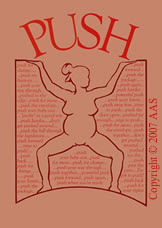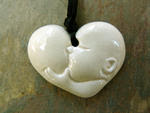By Janel Martin-Miranda, c 2006
During my years of working with women and children in various settings, I developed a lot of metaphors to explain otherwise complex human experiences. Each became a personal story and metaphor for that person. I share them in allegory form here to be helpful in the dialog about where birth is safest, home or hospital.
She said, she said. They're all perceptions.
During my years of working with women and children in various settings, I developed a lot of metaphors to explain otherwise complex human experiences. Each became a personal story and metaphor for that person. I share them in allegory form here to be helpful in the dialog about where birth is safest, home or hospital.
She said, she said. They're all perceptions.
Or, as I used to say in counseling, especially with couples, "Somewhere in the middle is a grain of absolute truth." Everything else is just perceptions.
If we were all gathered around a piano and had to describe what we see we would have a different view of the very same Piano.
If one sits in the front and describes the keyboards to those behind stating that this is what makes the music, “when I touch the keys”, those behind could argue to the end of time, “That is absolutely false.”
Those in the front could argue, most assuredly and adamantly, “It most certainly is, and I am doing it, I have done it. You cannot change my mind, because I SEE it and I FEEL it. I AM making the sound. I am doing it right now!”
Those in the back could absolutely totally deny it, “No, it’s not scientific, logical, I don’t see it, so it’s not there. THAT is not what is making the sound.”
Those in the back of the piano may be looking at a simple flat wall, or they could be viewing the internal workings of the piano. Then, they might be further arguing, “No, I see where the music is coming. I can see the parts moving. I am trained to know how this works. You can't know how it works. I am the trained piano tuner.”
The one in the front can be blue in the face, angry, or melodramatic some might say, “I DO know how it works. It is ME who is MOVING the keys here to make the music. I am the musician, and I play by ear, naturally.”
The one in the back, knowing that it takes the other touching the key board to make their own music, and knowing she can also make sounds from her side, says, “Nope, you are a liar, that’s impossible.” She continues, “In fact, I can make it stop, proving that you are wrong,” as that person reaches in to stop the music. A cacaphony of noise occurs. “See, THAT proves it. Furthermore, you can not prove that you can make music in tune without me here to make sure.”
Some others who are seated at the end of the piano, or who have aerial view can try to point out to the those in the back or front that both are right, but not perfectly. They also will likely not convince the other of their perception, that sure, the one who can get inside and tune the piano doesn’t have to do so for the other to play music. Gosh, in all parts of the world, people play the piano without the piano tuner right there with back all open.
“I may not understand how it works in there, I haven’t seen it or studied it, and I can’t fix it, but I do see that she is right, there are lots of black and white keys over here that she must move to make the music you hear. She is a musician. And, she doesn’t need you right there, with the back exposed to do so. What if you just tune it up before she plays and wait and see?”
The points of my metaphor are:
1- The only way to understand the perceptions of others is to be willing to acknowledge that you likely do not see the whole piano or every perspective. I call it acknowledging that one doesn’t know what one doesn’t know.
2- To move yourself so that you can try to see other’s perspectives of the very same thing – to learn what it is that you don’t know you don’t know.
If we were all gathered around a piano and had to describe what we see we would have a different view of the very same Piano.
If one sits in the front and describes the keyboards to those behind stating that this is what makes the music, “when I touch the keys”, those behind could argue to the end of time, “That is absolutely false.”
Those in the front could argue, most assuredly and adamantly, “It most certainly is, and I am doing it, I have done it. You cannot change my mind, because I SEE it and I FEEL it. I AM making the sound. I am doing it right now!”
Those in the back could absolutely totally deny it, “No, it’s not scientific, logical, I don’t see it, so it’s not there. THAT is not what is making the sound.”
Those in the back of the piano may be looking at a simple flat wall, or they could be viewing the internal workings of the piano. Then, they might be further arguing, “No, I see where the music is coming. I can see the parts moving. I am trained to know how this works. You can't know how it works. I am the trained piano tuner.”
The one in the front can be blue in the face, angry, or melodramatic some might say, “I DO know how it works. It is ME who is MOVING the keys here to make the music. I am the musician, and I play by ear, naturally.”
The one in the back, knowing that it takes the other touching the key board to make their own music, and knowing she can also make sounds from her side, says, “Nope, you are a liar, that’s impossible.” She continues, “In fact, I can make it stop, proving that you are wrong,” as that person reaches in to stop the music. A cacaphony of noise occurs. “See, THAT proves it. Furthermore, you can not prove that you can make music in tune without me here to make sure.”
Some others who are seated at the end of the piano, or who have aerial view can try to point out to the those in the back or front that both are right, but not perfectly. They also will likely not convince the other of their perception, that sure, the one who can get inside and tune the piano doesn’t have to do so for the other to play music. Gosh, in all parts of the world, people play the piano without the piano tuner right there with back all open.
“I may not understand how it works in there, I haven’t seen it or studied it, and I can’t fix it, but I do see that she is right, there are lots of black and white keys over here that she must move to make the music you hear. She is a musician. And, she doesn’t need you right there, with the back exposed to do so. What if you just tune it up before she plays and wait and see?”
The points of my metaphor are:
1- The only way to understand the perceptions of others is to be willing to acknowledge that you likely do not see the whole piano or every perspective. I call it acknowledging that one doesn’t know what one doesn’t know.
2- To move yourself so that you can try to see other’s perspectives of the very same thing – to learn what it is that you don’t know you don’t know.
3- One doesn't have to be a piano player to be a piano tuner and a piano tuner is not necessarily a musician.
You've been hit -- now what do you do?
This is a metaphor I used with young women who had been sexually abused and other Post-traumatic disorders.
You are driving down the road, maybe a very careful driver, maybe observing every traffic law. Maybe not. Maybe you are on the cell phone, car-dancing to your favorite tune, thinking about the fight you just had, rushing to pick up your child, or running for groceries to fix dinner. It doesn’t matter --- because suddenly from nowhere, someone runs a red light and crashes in to you.
From that moment on YOU have the responsibility for how you react to every aspect of the situation. You can get out of the car and begin screaming profanities. You can rush over (hopefully) to see if the others are ok. You can leave the scene, cry, take a nap.
Truthfully, one’s reaction will often be dependent upon our perceptions of the other driver and the judgements, assumptions, and course of personal action are often reactive depending on the other, the one who did the wrong. Was it a group of teenagers, a mother rushing her child to the ER, a little old lady who confused the gas and brake pedals, a drunk driver, or an obstetrician rushing to the hospital to deliver a baby, some we know with whom we already have a relationship (good, bad, or otherwise, like our minister, our neighbor with whom we have a conflict). Too often, we humans reaction according to the judgements we make about the other.
The bottom line is the damage is done. The one harmed has choices about how they perceive themselves, their role, the other who harmed them. YOU now have the responsibility of going through the legal aspects and the steps to fix the car. You have to contact your insurance agent, you have to get quotes to fix it, you have to take it get it fixed and do without it. Maybe you have to take time off from your schedule to do these things, or you can’t, or you don’t have transportation during the process. You choose every minute of how you decide to response. A problem is the psychophysioemotional aspects that keep coming up -- fueled by hormones, perceptions, and response of the other (PTSD).
You may have been injured – even severely and that is whole other level to what you have to DO and PROCESS as a result of someone coming along and bashing into you. Maybe your car was brand new, maybe it had been a gift, maybe the other is uninsured and you fight your insurance company. A million and one things are possible. And, it’s a pretty good chance that you were not totally observant and not being the ideal, law-biding driver. YOU could be the "other." Every day in every relationship we somehow harm or trigger another's button even if we are being totally aware, concerned, and compassionate about the other. In the commission of living our lives and woundings, we unknowingly, unwittingly can interfere with or harm the other's way of being. I call them intersections, or inner-sections -- where our woundings bump up against the woundings of others.
What is your contribution? Even if there was not a thing you could have done differently how DO you deal with the feelings of not being a good driver that COULD have contributed?
You might have been injured enough and your life altered enough that you became restricted in your life (even never walked again), or depressed for a long time. Maybe you were pregnant and your baby was born prematurely or did not live. Whatever it was, it contributed to your future life, your feelings, perceptions, and maybe your depression, rooted in the event, lead to the inability to make appropriate decisions that lead to further unwanted complications. You might have lost your job, then your apartment, and had to move in with friends or family. Or, you got addicted to painkillers, neglected your child and lost custody of that child to the other parent. Left college and became a bum.
Who is to blame? How does one get out of the cycle of victimization and out of the spin of PTSD? What if the person who hit you has a long record of such accidents? What if it were totally preventable? What if that particular intersection is a block from the hospital where there is scientifically or statistically a high number of accidents due to obstetricians rushing to the hospital? And, the city won’t do anything about it, because of pressure and money from the hospital.
Birth as a Metaphor
Birth is so about being responsible for who one is when they conceive and about where they are going in any one second of life – how one is gestating that baby nutritionally, environmentally, relationally. One’s own fears, hopes, stresses, and needs are all driving one down the road to that intersection of birth, where 90% of the time one is going to intersect with a rushing obstetrician.
How did we get here? With all of these paved roads, four lanes, lights, traffic laws, rushing obstetricians?
TO BE CONTINUED …..








No comments:
Post a Comment